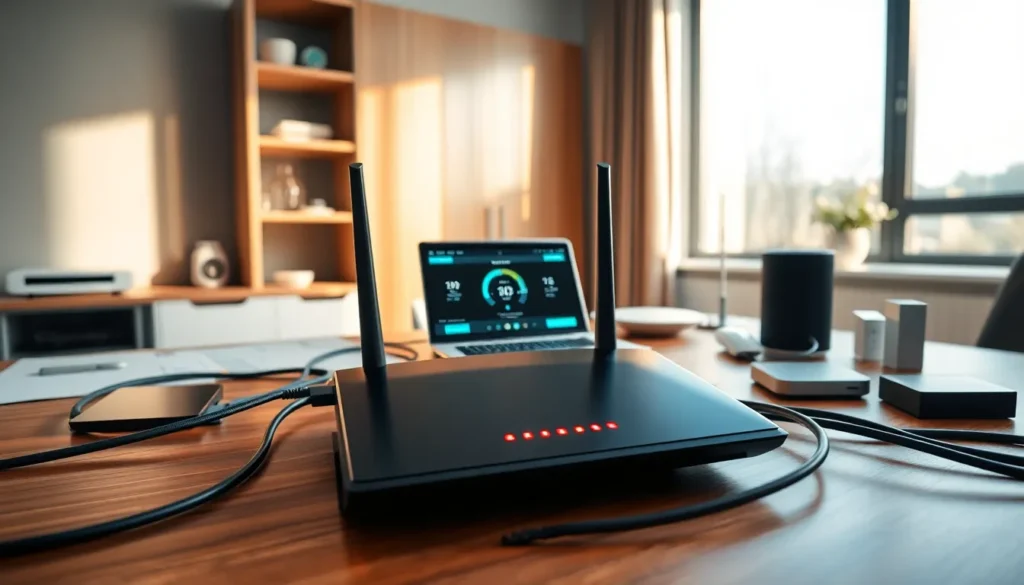Table of Contents
ToggleEver tried to connect to the Wi-Fi while someone’s streaming a movie, and it feels like a second-hand dial-up connection? Frustrating, right? Welcome to the world of home networking, where you can master the art of connectivity and keep the digital chaos at bay. Whether you’re a tech novice or a seasoned guru, this home networking guide will turn your living space into a seamless, high-speed sanctuary. Buckle up, grab a snack, and let’s jump into the essentials of creating a network that could rival even the fastest coffee shop Wi-Fi.
Understanding Home Networking Basics

Home networking is about connecting multiple devices to the internet and to each other in a cohesive manner. It’s like hosting a party, everyone needs to interact without stepping on toes. Key components include the internet connection, a router, and several devices, all working together harmoniously. The primary goal is to enable smooth data sharing, internet access, and communication across devices, from computers to smart home gadgets.
Home networks typically operate using a combination of wired and wireless connections. Imagine a highway where some cars drive on paved roads, while others zip along the bike lanes. Wired connections, like Ethernet cables, provide stability and speed, ideal for gaming consoles or desktops. But, wireless connections, such as Wi-Fi, offer flexibility, letting smartphones and tablets roam freely around the house. Understanding these basics is crucial to constructing a home network that meets every user’s needs.
Types of Home Networks
When it comes to home networks, one size does not fit all. There are several different types, each with its own unique benefits and use cases:
- Wired Network: This type relies on physical cables. It’s considered the most stable and fastest option for data transfer, making it perfect for high-bandwidth activities like gaming and HD streaming.
- Wireless Network (Wi-Fi): Offers convenience and flexibility. With Wi-Fi, you can connect various devices from anywhere in your home without dreading those pesky cords. Ideal for families who move around a lot.
- Guest Network: A separate access point specifically for visitors. This not only keeps the main network secure but also prevents inexperienced users from accidentally tinkering with settings or introducing viruses.
- Home Automation Network: As smart devices proliferate, this type integrates all connected home gadgets, making life simpler with devices like smart speakers and lights communicating effortlessly.
Understanding these types allows anyone to choose or design a network that best fits their lifestyle.
Essential Networking Equipment
To build a robust home network, certain equipment stands out as essential:
- Router: The heart of the home network, responsible for directing traffic between your devices and the internet. Choosing a dual-band or tri-band router can help manage multiple connections, especially in larger homes.
- Modem: This device connects to your Internet Service Provider (ISP) and translates the signal into something your router can use. Often, you’ll see combined router/modem units in stores.
- Ethernet Cables: For those who prefer stability, Ethernet cables allow direct connections between the router and devices. They’re a must-have for gamers and those streaming 4K content.
- Switch: If more devices need to be connected than the router can handle, a switch helps add more Ethernet ports easily.
- Access Points: These expand wireless coverage in larger homes, ensuring that every nook and cranny gets the signal it deserves.
Having the right equipment not only enhances performance but also ensures longevity and stability in your network.
Setting Up Your Home Network
Setting up a home network may sound daunting, but with a bit of planning, it can be straightforward. Here’s how to get started:
- Choose Your Location: It’s essential to place the router in a central spot in the house, preferably elevated, to maximize coverage. The less interference, the better.
- Connect Modem to Router: Use an Ethernet cable to connect the modem to the WAN port of the router, allowing the router to deliver internet to devices.
- Configuring the Router: Access the router’s configuration page via a web browser. Customize settings such as Wi-Fi name and password to ensure security.
- Connect Devices: Now connect devices either via Ethernet or Wi-Fi. Each device should detect the network, prompting for a password.
- Test Speed and Coverage: Use apps like Speedtest to check the internet speed and adjust router placement as needed, ensuring no dead zones exist in the house.
Following these simple steps, anyone can create a reliable and efficient home network.
Securing Your Home Network
Security is crucial in preventing unwanted access to your network. Here are some effective strategies:
- Change Default Logins: Many routers come with default usernames and passwords that are widely known. Changing these should be the first step in securing your network.
- Use Strong Passwords: Create complex passwords for your Wi-Fi and network access that combine letters, numbers, and special characters.
- Enable WPA3 Encryption: If available, this is currently the strongest encryption standard and protects your data.
- Regularly Update Firmware: Manufacturers push updates for a reason, often to fix security vulnerabilities. Keeping the firmware up-to-date is crucial.
- Disable WPS: Wi-Fi Protected Setup (WPS) can be an easy target for hackers. Disabling it ensures that only manually entered passwords can connect to your network.
Implementing these measures is not just smart: it’s essential in today’s digital world.
Troubleshooting Common Network Issues
Network glitches can arise unexpectedly, leaving you bewildered. Here are some common issues and their solutions:
- Slow Speeds: If internet speed drops, begin with a speed test. If speeds are below what you pay for, restart the router and modem. Sometimes a simple reboot solves everything.
- Inconsistent Connections: If devices keep disconnecting, this often indicates signal issues. Check router placement, and if necessary, consider range extenders.
- Unable to Connect: Double-check that the Wi-Fi is active and that the correct password is being used. If it’s still an issue, forgetting the network on the device and reconnecting may help.
- Overloaded Network: Too many devices using bandwidth can slow things down. Recognizing which devices take up the most resources, especially streaming devices, can help prioritize traffic effectively.
Troubleshooting often requires patience, but following a methodical approach can usually resolve issues swiftly.
Future Trends in Home Networking
As technology evolves, home networking is expected to change dramatically. Here are some trends shaping the future:
- Wi-Fi 6: The latest generation of Wi-Fi promises faster speeds, greater capacity, and improved efficiency. As more devices become smart, this upgrade will be essential to support them.
- Mesh Networks: These systems offer seamless coverage throughout a home, eliminating dead zones entirely. They represent a significant improvement over traditional routers for larger spaces.
- AI-Driven Networks: With artificial intelligence, networks will optimize themselves based on usage patterns, providing priority to different devices when needed.
- Security Innovations: Expect to see advanced security protocols that learn and adapt, proactively protecting against intrusions.
As these trends unfold, homeowners should stay tuned to the latest technologies to ensure their networks not only perform well but also remain secure.





